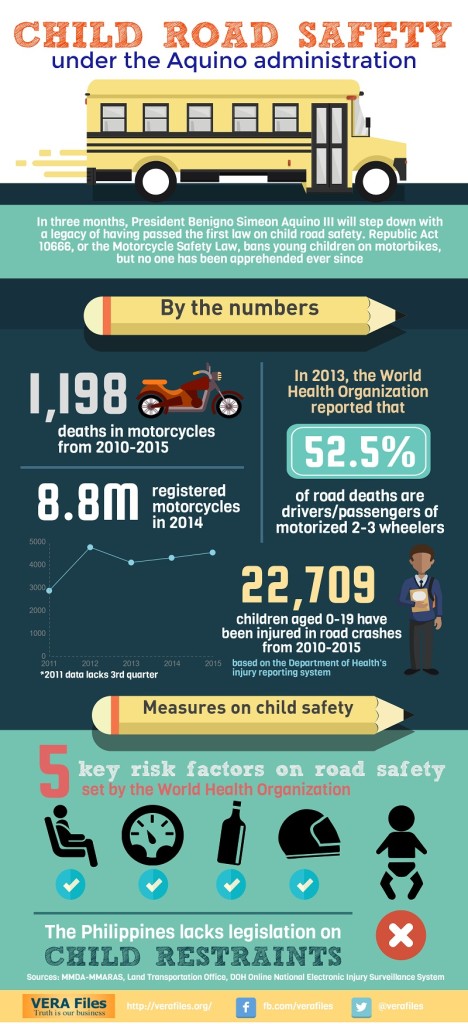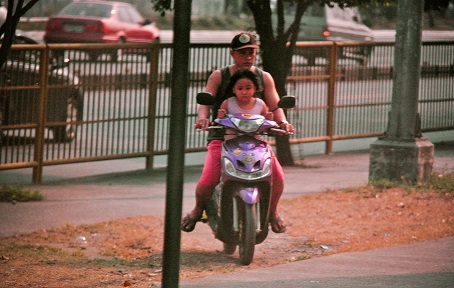By Maria Feona Imperial, VERA Files
Ask all five presidential candidates about their plans for children and most of them would touch on providing classrooms and free lunch for undernourished kids.
When it comes to transport issues, they would often discuss the worsening traffic problem in urban areas and their plans to solve it.
This election season, road safety was almost never talked about. Even if every day, around 263 children fall victim to road crashes, the Department of Transportation and Communications (DOTC) estimates.
In three months, President Benigno Simeon Aquino III will step down with a legacy of having enacted a landmark law on child road safety. But that law has yet to be fully implemented, exposing more Filipino children to risks every day.
Passed in July, Republic Act 10666 or the Motorcycle Safety Act, bans young children aboard motorbikes, unless they can plant their feet on the foot peg, wrap their arms around the driver’s waist and wear protective helmets.
The newly passed law on motorcycles is not meant to “restrict their rights to visibility nor to penalize those who cannot afford to buy four-wheeled vehicles, but more to protect children who cannot enact laws for themselves,” Tanseco said.
For road safety advocates, the Philippines direly needs this law, in a country where motorcycles account for half of road deaths.
Under Aquino’s term, a total of 1,198 people aboard motorcycles have been killed, data from the Metro Manila Development Authority (MMDA) show.
Children, the most vulnerable among road users, aren’t spared.
From 2010 to 2015, around 22,700 children aged 19 and below, or at least 12 children per day, have either been killed or injured in road crashes, based on the Department of Health’s injury reporting system.

Though glaring, these figures are far from complete. Reports are sourced from only two to nine percent of hospitals in the country — that is, if the victims get to the hospital.
RA 10666 could have helped suppress these incidents, but almost a year after the law’s passage, no one has been sanctioned due to the lack of implementing rules and regulations (IRR).
The IRR remains unsigned by Assistant Secretary Robert Cabrera of the Land Transportation Office (LTO), the lead agency tasked to create the document, five months past the deadline.
Only after Cabrera has signed the IRR can it be forwarded to the DOTC, and from there await the go-signal of transportation secretary Joseph Emilio Abaya.
The IRR has been drafted and submitted in October, said Roberto Valera, who heads the traffic safety department of the LTO. Valera, however, did not provide reasons for the delay.
The LTO should be held accountable at this point, said lawyer and road safety advocate Evita Marie Ricafort.
‘Too many exceptions, very limited coverage’
Beyond delays in the bureaucratic process, Ricafort pointed out that some provisions of the law remain contentious. While the law seeks to protect young children, the draft IRR has defined the scope of children as those 18 and below.
Valera, who was part of the team that drafted the rules, said they adopted the definition of the “child” from the law’s definition of minors, or those needing consent from parents on legal decisions.
“‘Yun yung spirit ng law, sa maliliit na bata. Pero wala eh (That’s the spirit of the law; it is intended for young children but you don’t see it in the law),” she said.
For Ricafort, however, this contradicts the minimum age requirement of 16 years old, which allows one to apply for a non-professional or student driver license.
So every time traffic constables and police officers would call out riders for violations, Ricafort said they would first have to ask and verify the ages of violators.
Also, the law has “too many exceptions, but very limited coverage,” Ricafort said.
The prohibition will only apply if it is on the road, if there is a high density of fast moving vehicles and a high volume of cars, and if the vehicle is running faster than the speed limit of 60 kph.
“So, you can imagine yung dami ng situations na hindi mag-aapply (the many situations in which the law won’t apply),” she said.
“It is a good direction for child road safety, but the law could have afforded greater protection,” she added.
Police Superintendent Oliver Tanseco said “The newly passed law on motorcycles is not meant to “restrict their rights to visibility nor to penalize those who cannot afford to buy four-wheeled vehicles, but more to protect children who cannot enact laws for themselves.”
‘Strict on the accused, liberal on enforcers’
A law enforcer himself, Tanseco thinks the law is “strict on the accused, and liberal to road enforcers” due to economic factors.
The reason behind the high ownership of motorcycles is that it is an affordable, or sometimes, the only option for families who are minimum wage earners, Tanseco said.
Per LTO data, there are 8,801,224 registered motorcycles in the country as of 2014.
Among the law’s exceptions is that a child should be able to wrap his or her arms around the driver’s waist. This prevents instances of two or more children riding at the back of motorbikes — a common scenario in urban and rural roads.
As early as four, children in the Philippines are often trained to ride on motorcycles, amid a steady stream of trucks, buses and cars in highways spanning four lanes. When they leave for school, they are told to wrap their arms around their parents’, other times, the other sibling’s waist.
Data from the police and the MMDA are not disaggregated to show how many children have been involved in road crashes.
Had there been a comprehensive and streamlined data collection system on road crashes involving children, Ricafort says it would have been easier to press the government to take action.
Lack of reliable, consistent data on road crashes
Tanseco admits that the Philippine National Police does not give much premium on collecting road safety data. Their focus is more on tracking carnapping incidents, the mandate of the PNP being anti-criminality.
The lack of data on road safety can also be traced to underreporting of road crashes by law enforcers.
“If you are a law enforcer, would you want na maraming road crash?” he asked. “That means hindi ka (you’re not) effective.”
On the other hand, he said law enforcers sometimes resort to overreporting, especially if they want more resources within their territories.

Child restraints
A man and a child aboard a motorcycle on a Quezon City sidewalk violates the provisions of the newly passed Motorcycle Safety Law. Photo by Maria Feona Imperial[/caption]The World Health Organization has identified five risk factors on road safety, including helmet use, seatbelt use, drink-driving, speed limits and child restraints.
The Philippines still doesn’t have a legislation on child restraints, which would require private cars and public utility vehicles (PUVs) to install child safety seats to protect children from injuries in case of collisions.
Three measures on child restraints have been drafted in Congress. Only the version of Senator Jinggoy Estrada involves PUVs, which, may many observe may be hard to enforce in the Philippine setting.
‘Implementation nightmare’
Despite intentions to ensure child safety, both RA 10666 and a child restraint law would probably be met with resistance due to added expenses. In the Philippines, the idea of child restraints has yet to be widely accepted. “You can only imagine the reactions of the people,” Ricafort said.
Because car seats are estimated to cost around P5,000-8,000, most people would dismiss it as a first world problem, she said.
At times, they could even argue that there is no need for a child restraint law in the Philippines, given the high volume of road traffic.
“But the common argument is if you can afford to buy a car, you can afford to buy child restraints for your car,” Ricafort said.
The bigger concern, however, is an “implementation nightmare” for public utility vehicles such as jeepneys and buses.
“Child restraints may not be accepted in our culture,” Ricafort said, for a country whose compliance with existing seatbelt and helmet laws is poor.
Massive retrofitting
Government should thus consider subsidizing child restraints for PUVs, as well as families in the lower economic brackets, should the law be implemented, Ricafort said.
It can adopt programs where manufacturers and distributors of car seats would be encouraged to invest in the Philippines, she added.
Estrada’s proposed measure also provides a leeway of one year to retrofit PUVs to accommodate child safety seats.
Laws on child safety must also have provisions on whom to hold accountable in case of failure in implementation. Ricafort said the law requires constant review based on annual status reports.
Road safety not a political priority
Unless their relatives fall victim to road crashes, most Filipinos perceive safeguards such as child restraints and motorcycle safety laws as an added burden to their freedom to movement as well as self-expression, Tanseco said.
In the government, meanwhile, Ricafort said talks on transportation are confined to the worsening traffic problem because it impacts many.
“Government should always work on implementing and enforcing the law that we already have and also actively work to address the gaps that we have in our legal system,” she said.
Tanseco does not discount the possibility of RA 10666 being a scheme for corruption, but hopes it wouldn’t be another way for erring law enforcers “to milk the low wage earners.”
The alternative, Ricafort said, is an excellent mass transport system. “But we don’t have that.”
In the meantime, most Filipinos would have to do with motorcycle as the affordable family vehicle — even if it endangers the safety of young children.
(This article was written under a Road Safety Journalism Fellowship, organized by the World Health Organization, in collaboration with the Department of Transportation and Communication and in partnership with VERA Files.)
(VERA Files is put out by veteran journalists taking a deeper look at current issues. Vera is Latin for “true.”)
Road safety is usually the domain of Local Govt following the Guidelines established by Seniour Govts. For examples child restraints is Mandatory and Local Govt Must Enforce the rules. If the local school board can afford it, Busing Children to School in safety ,certified Scholol Buses is the Way to go with safety certified Operators. And also ,children under a specific age should be Free on all Public Transport. ( out Public Transit give our Children Under the Age of 12 free Ride and Studebts a 40 %discount, same as Seniours. ). Pls note that our Mass Teansit is also Publicly Subsidized and that is the idea of SAFE Public transport. Take away the PROFIT Motives. And taxpayers to Stop whining.